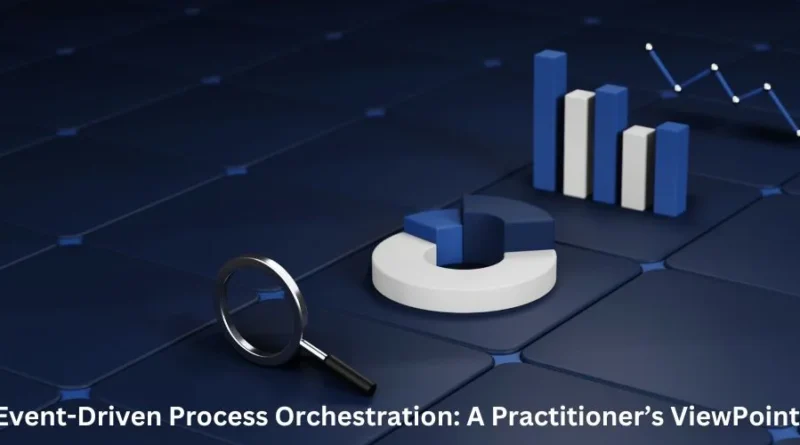Event-Driven Process Orchestration: A Practitioner’s Viewpoint
In the evolving landscape of business processes and technological advancements, Event-Driven Process Orchestration: A Practitioner’s Viewpoint emerged as a powerful approach for managing and automating complex workflows. This methodology, grounded in the real-time response to events, offers a dynamic way to streamline operations and enhance efficiency. In this article, we will explore event-driven process orchestration from a practitioner’s viewpoint, delving into its benefits, implementation strategies, and real-world applications.
Event-Driven Process Orchestration: A Practitioner’s Viewpoint
Event-Driven Process Orchestration: A Practitioner’s Viewpoint the coordination and management of business processes in response to specific events or triggers. Unlike traditional process management systems that operate on a predefined sequence of tasks, event-driven orchestration reacts to events as they occur, enabling a more agile and flexible approach to workflow management. This approach is particularly valuable in environments where processes are complex and require real-time adjustments.
Benefits of Event-Driven Process Orchestration
- Real-Time Responsiveness: One of the primary advantages of Event-Driven Process Orchestration: A Practitioner’s Viewpoint its ability to respond to events in real-time. This responsiveness ensures that processes are executed promptly, reducing delays and enhancing operational efficiency.
- Scalability: Event-Driven Process Orchestration: A Practitioner’s Viewpoint . As the volume of events increases, the system can handle the load without significant performance degradation. This scalability is crucial for businesses that experience fluctuating workloads.
- Flexibility: Traditional process management systems often struggle with changes. Event-Driven Process Orchestration: A Practitioner’s Viewpoint however, is designed to adapt to changes seamlessly. This flexibility allows organizations to modify processes on-the-fly, responding to new requirements and opportunities.
- Improved Monitoring and Analytics: Event-driven process orchestration provides detailed insights into process performance. By tracking events and their outcomes, organizations can gain valuable analytics that inform decision-making and continuous improvement efforts.
Implementing Event-Driven Process Orchestration
For practitioners looking to implement event-driven process orchestration, several key considerations must be addressed:
- Event Identification and Classification: The first step is to identify and classify events that will trigger processes. These events can be anything from customer actions (e.g., placing an order) to system-generated events (e.g., a server error).
- Defining Workflows: Once events are identified, workflows need to be defined. This involves mapping out the sequence of actions that should occur in response to each event. Tools like Business Process Model and Notation (BPMN) can be useful for visualizing these workflows.
- Choosing the Right Technology Stack: Selecting the appropriate technology stack is critical for successful implementation. This includes choosing event brokers, orchestration platforms, and integration tools that support event-driven architectures.
- Testing and Validation: Before going live, it’s essential to thoroughly test the system. This includes validating that events trigger the correct processes and that workflows execute as expected. Simulation tools can be helpful in this phase.
Real-World Applications of Event-Driven Process Orchestration
Event-driven process orchestration is applicable across various industries and use cases. Here are a few examples:
- E-Commerce: In e-commerce, event-driven orchestration can automate order processing, inventory management, and customer notifications. For instance, when a customer places an order, an event is triggered that initiates a series of actions, such as updating inventory, processing payment, and sending a confirmation email.
- Financial Services: In the financial sector, event-driven process orchestration can enhance fraud detection and compliance monitoring. Events such as unusual transaction patterns can trigger immediate investigation processes, ensuring timely intervention.
- Healthcare: In healthcare, event-driven systems can improve patient care by automating processes like appointment scheduling, prescription renewals, and emergency response. For example, an event indicating a critical change in a patient’s condition can trigger an alert to medical staff, ensuring rapid response.
- Telecommunications: Telecom companies can use event-driven orchestration to manage network operations and customer service. Events such as network outages can trigger automated workflows to diagnose and resolve issues, minimizing downtime.
Challenges and Considerations
While event-driven process orchestration offers numerous benefits, it also presents certain challenges:
- Complexity: Implementing and managing an event-driven system can be complex. It requires careful planning and a deep understanding of the workflows and events involved.
- Integration: Integrating event-driven orchestration with existing systems can be challenging. Ensuring compatibility and seamless communication between different components is crucial.
- Monitoring and Maintenance: Continuous monitoring and maintenance are essential to ensure the system operates smoothly. This includes regular updates and troubleshooting to address any issues that arise.
- Security: Protecting sensitive data and ensuring secure communication between systems is a top priority. Practitioners must implement robust security measures to safeguard against potential threats.
Conclusion
Event-driven process orchestration represents a significant shift in how businesses manage and automate their workflows. From real-time responsiveness and scalability to flexibility and improved analytics, the benefits of this approach are substantial. However, successful implementation requires careful planning, the right technology stack, and continuous monitoring.
From a practitioner’s viewpoint, the journey to event-driven process orchestration is both challenging and rewarding. By leveraging this methodology, organizations can achieve greater efficiency, agility, and innovation in their operations. Whether in e-commerce, financial services, healthcare, or telecommunications, event-driven process orchestration is poised to transform the way businesses operate in the digital age.
YOU MAY ALSO READ
errordomain=nscocoaerrordomain&errormessage=could not find the specified shortcut.&errorcode=4

Pingback: Exploring the Life and Achievements of Noah Lee Ritter: A Comprehensive Overview - BIG FUL NEWS